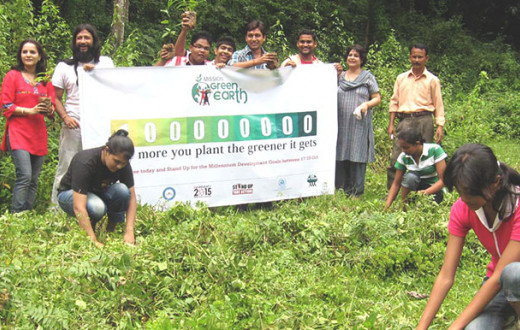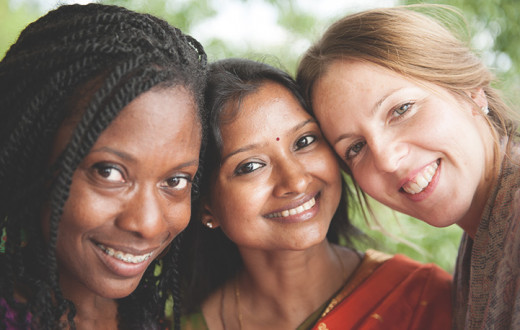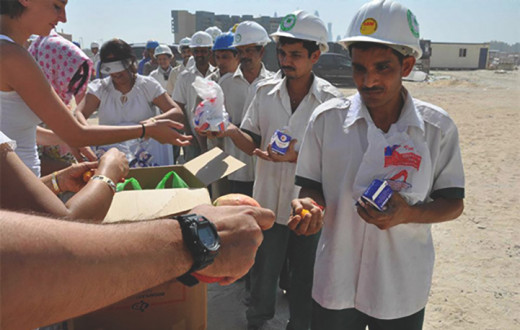Pokrok jakékoli země je přímo spojen s rozvojem venkova. Trvalé transformace venkova lze dosáhnout pouze komplexním přístupem, který zvažuje a integruje všechny aspekty včetně hospodářského, sociálního a environmentálního. Aby byla každá změna udržitelná, musí začít zevnitř. V programech rozvoje venkova, které provozuje Art of Living, se klade důraz na posílení místních komunit a na to, aby se ony sami staly nositeli změn. Program „Trénink mladých lídrů“ (Youth Leadership Training Program - YLTP) dává mladým lidem dovednosti, motivaci a schopnosti iniciovat a vést servisní projekty ve vlastních vesnicích a komunitách na základě jejich potřeb. Je to kombinace osobní vnitřní síly a školení dovedností a schopností vést, která jim umožňuje rozvoj venkova.
Přístup
Základem transformace venkova v podání Art of Living v Indii je posílení postavení mladých venkovských vůdců zvaných „Yuvacharya“. Jedná se o bystré mladé muže a ženy, kteří byli vybráni ze stejného venkovského prostředí a rozvíjeli se v různorodých oblastech v rámci Vzdělávacího programu pro mládež (Youth Leadership Training Program - YLTP).
To jim dává dovednosti, motivaci a schopnosti iniciovat a vést servisní projekty ve vlastních vesnicích a komunitách na základě jejich potřeb. Právě tato kombinace vnitřní síly, dovedností a schopnosti vést, jim umožňuje rozvoj venkova.
Yuvacharyas využívají model rozvoje od Art of Living zvaný 5H:
- Zdraví (Health) - fyzické, psychické, finanční a environmentální
- Domov pro bezdomovce (Homes for the homeless)
- Hygiena (Hygiene)
- Lidské hodnoty (Human Values)/li>
- Harmonie v rozmanitosti (Harmony in Diversity)
5H příznivě ovlivňuje sociální transformaci a snaží se vymýtit chudobu, bídu a nemoci a zajistit mír a harmonii ve venkovských a kmenových oblastech po celém světě.
Dopad na Indii
70 000 vesnic v Indii
dosáhl
203 220 venkovské mládeže
vyškoleno prostřednictvím Vzdělávacího programu pro mládež/p>
165 000 bezplatných workshopů na zmírnění stresu
pro více než 5 688 000 osob
52 466 hygienických táborů
ve prospěch 7 869 900 lidí
27 427 lékařských táborů
s přínosem pro 577 400 osob
3 819 domovů
postaveno
15 000 toalet
postavených pro zlepšení zdraví místních vesničanů
1 199 vrtů
realizovaných, které nabízejí pravidelný přísun vody
904 bioplynových stanic
nabízejících alternativní palivové řešení
55 modelových vesnic
rozvinutých
65 000 lidí
z více než 16 500 domácností těží ze slunečního osvětlení
98 solárních podnikatelů
vyškolených a poskytující čistou energii 4 000 venkovským rodinám
Projekty transformace venkova
- Rural Electrification
- Holistic Development
- Community Work
- Sanitation & Hygiene
- Youth Leadership
360 million people in India i.e. roughly 40 percent of rural households do not have access to electricity. A majority of these people rely on kerosene and other fuels to meet their lighting needs, which is hazardous to both their health and to the environment. Every year 2.2 million litres of kerosene is burned for lighting, emitting approximately 5.5 million tonnes of carbon dioxide. Traditional fuel combustion, the primary source of indoor air pollution, causes between 300,000-400,000 deaths per year in India alone.
Initiated in 2012, The Art of Living’s vision to ‘Light a Million Homes’ is an on-going campaign inspiring individuals and corporate partners to work with us to bring clean and affordable lighting solutions to un-electrified homes and villages in India and in Nepal.
The Light a Home follows an integrated approach that combines multiple elements of rural transformation including building rural entrepreneurs. While there is still a journey to be completed, smiles are already lighting up thousands of faces as they begin to experience the benefits of this project.
Some highlights:
Assam: India’s largest solar battery charging station launched to power 287 houses on a remote island in Dibrugarh, Assam in December 2016. With women heading the implementation, the portable solution has been installed on a sandy island.
West Bengal: India gets its solar-powered village in Bengal through the Light a Million Homes project. This is India first de-centeralized solar electrification project.
- Arunachal Pradesh: 33 homes light up in the remote regions
- Jammu & Kashmir: Two schools fully electrified after the 2014 floods
- Tamil Nadu: A remote tribal settlement of Kodamban Kombai in the Nilgiri forest was electrified for the first time
- Karnataka: Three remote villages on the border of Karnataka and Goa got electricity for the first time in their history
- Maharashtra: Solar lamps provide portable electricity to nomadic laborers who are migrants and travel from place to place
The rural development program aims at developing a village and addressing their specific socio-economic problems. This development comes from empowering the individual and creating sustainable solutions.
KAPSI: Creating Change at the Grassroots
Life has changed completely for Dadasaheb Khatar, a farmer who lives in Kapsi village on the dusty two-lane Phalton-Satara highway. His days of waiting are over. He no longer looks out for the tankers from Phalton that used to bring them 12,000 liters of water every two days for his cows, his family, and his fields. He now gets water from one of the many check dams built in his village by volunteers of The Art of Living. Kapsi is one of 1,200 villages in Maharashtra that has been transformed on many fronts due to the tremendous efforts put in by The Art of Living volunteers.
With a population of approximately 1,700 people and no industrial activity even in the nearby villages, drought conditions from 2000 to 2003 had put the village back by almost 20 years. Dr. Madhav Pol, an Art of Living teacher, decided to take charge. Taking inspiration from the 5H program designed by Gurudev, he, along with the sarpanch (the village heads) and a few villagers, decided to tackle the problem at its roots. And today, the village is prospering.
“What could be better? Today there is water everywhere. The water tables have risen and when we think of our previous situation, it's unbelievable. What could be better for a farmer than having enough water?”
- Dr. Madhav Pol, Art of Living Project Coordinator
Empowerment of a community begins with the individual. Through the leadership programs, the aim is to strengthen each person, bring out their potential and inspire community service. There are several examples of entire communities being transformed through our programs.
Nouvelle Vie Haiti
Nouvelle Vie, a new generation of Haitian leadership, which had the vision to innovate and create sustainable solutions in the spirit of selfless service.
Already crippled from the long-term effects of poverty and environmental disasters, Haitians suffered greatly from the trauma of the January 12, 2007 earthquake.
Recognized as one of Haiti’s top leadership development programs by the World Bank and UNICEF and partly funded through USAID, Nouvelle Vie offered empowerment, environmental, and social programs to 150-200 community members every month for 5 years, hosting a rooftop demonstration garden and developing 20-30 volunteers as future leaders and trainers.
The program ran from 2007-2012, powered by dedicated volunteers and Art of Living teachers. Committed to programmatic sustainability and local leadership, Nouvelle Vie Haiti trained a team of 19 participants as leadership trainers. Since July, 2011, these Haitians leaders have been serving their communities through leadership, Art of Living's trauma relief and empowerment workshops, and sustainable community development initiatives, reaching about 2,000 people since 2012.
Our Impact
350
youth leaders trained
19
leaders trained as trainers
9,867
community members gain trauma and empowerment skills
602
youth trained in sex education
152
vulnerable children mentored by the community
3,152
children and adults learn to grow their own food
A 2003 study by Mumbai-based SNDT University found that of the 1,017 rural women interviewed, only five had toilets at home. Others used fields and open spaces for defecation. This prompted The Art of Living to take up toilet construction as one of the key elements to social intervention initiatives.
Manek Chaudhari, an agriculturist, was cheated out of his business. Bitter, he left home and turned to gambling. On returning after 3 years, his friend enrolled him to the Youth Leadership Training Program and he felt the negativity in him was scrubbed off.
Manek began teaching in villages and raised awareness about the need for toilets. Villagers resisted, as toilets in the village might mean the village gets dirty (they had been using the vast expanse of nature outside their villages as their toilets for centuries.) The concept of closed toilets and drainage had to be explained to them.
Earlier, only 3 – 4 homes had toilets. Through this project, all homes were provided with toilets.
“It was difficult for ladies who used to wait till sunset so that they could go in privacy. The toilets are a blessing for the women of the village,” shares Govind Bhai, a villager from Surat.
Bhavesh Patel and his team constructed close to 400 toilets in different villages of Umarpuda Thaluka in Surat district as per the government’s plan.
In 2007, The Art of Living was invited by the government to help with the implementation of the Rajiv Awas Yojana to build 60 houses in Khoutharampura.
“Where to relieve ourselves was not a choice at all. When we use fields and open spaces for defecation, we are always subject to fear of being shouted at, exposed to indignities and insulted. Many of our perennial health problems vanished after we got this toilet.” - Gangamma, one of the beneficiaries for a scheme under which 175 toilets were built.
- Toilets story - MH (300+ built in 20 days)
- Sanitary napkin dispensers installed in schools (on March 8th Women's Day - 2017)
Developing local leadership is an important component of the 5H program. Through the leadership programs, youth are encouraged to develop their skills and abilities and take responsibility for their communities.
This time, in Africa
The 1st Saka iSouth Africa (Building South Africa project) team conducted the first youth leadership training program in the last week of November 2004. Youth came from far and wide from Cape Town, Gauteng, Mpumalanga, & KwaZulu Natal, with 40 of them graduating as youth leaders.
The Breath Water Sound Workshop teachers and children yoga teachers are working in the townships of South Africa. Our Saka iSouth Africa leaders were trained not only in leadership but were also exposed to further training in organic farming, communication and self-esteem, project management, proposal writing, UBUNTU, democracy & citizenship, waste management, and much more to make them the very best leaders that they can be.
5H Service and upliftment projects such as operating a computer training facility, pickle making business, mosaic project, organic gardening, etc. were undertaken by youth leaders in the townships.






